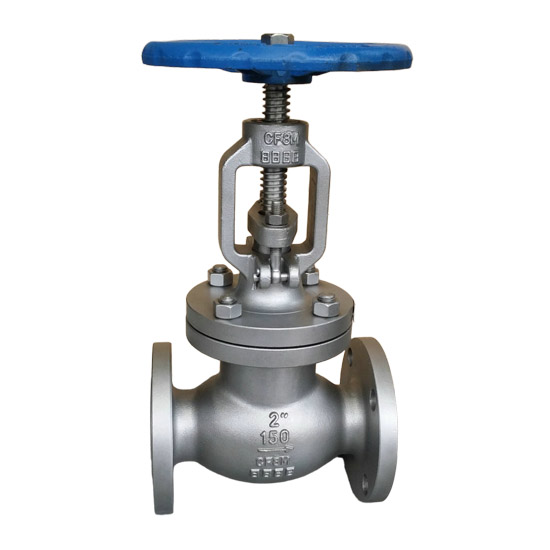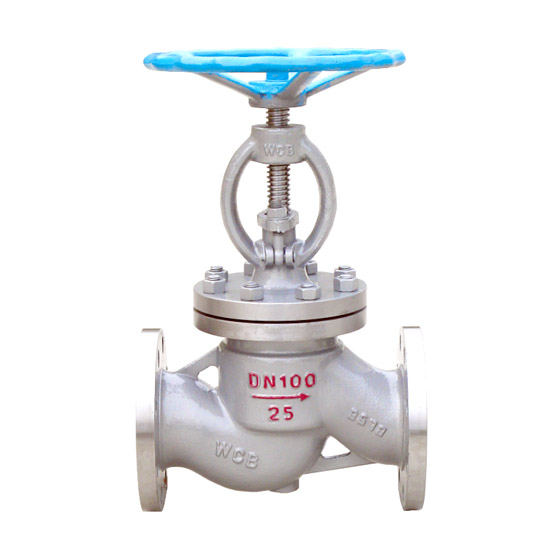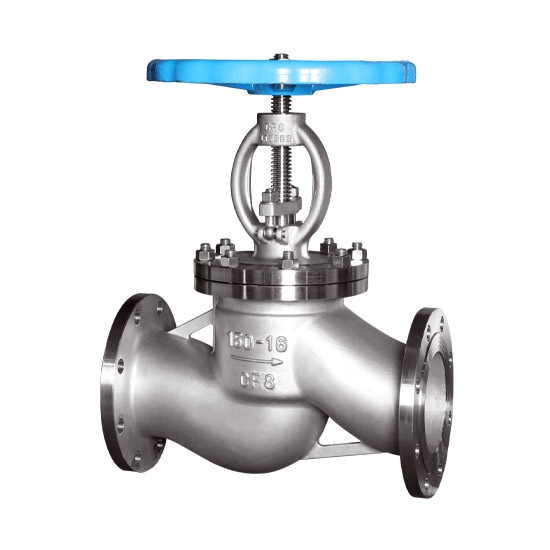Ⅰ. Product Overview
1. Features
The American Standard Globe Valve is a shut-off valve that controls medium flow by vertically lifting or lowering the disc along the stem. It is widely used in petroleum, chemical, power generation, and energy industries. Key features include:
Unidirectional Flow Design: Medium flow direction strictly follows the arrow marked on the valve body (typically low-in, high-out). When closed, medium pressure assists the disc in sealing tightly against the seat, enhancing sealing performance.
Metal-to-Metal Sealing: The disc and seat use metallic sealing surfaces (e.g., Stellite alloy, hardened stainless steel), suitable for high temperature, high pressure, clean or mildly corrosive media such as water, steam, oil, and weak acids/alkalis.
Rising Stem Mechanism: The stem is fully exposed and moves with the disc (trapezoidal thread drive). The number of handwheel turns intuitively indicates valve opening (fully open → stem at top, fully closed → stem at bottom).
Various Structural Forms: Includes straight-through (most common), Y-pattern (low flow resistance), angle type (space-constrained applications), and bellows-sealed type (zero external leakage requirement).
Flexible Actuation Options: Supports manual (handwheel/worm gear), electric, pneumatic, or gearbox operation, suitable for automated control systems.
2. Model Coding System
Example: J41Y-150LB
Type Code: J (Globe Valve)
Connection Type: 4 (Flanged ANSI B16.5), 6 (Welded End ANSI B16.25)
Sealing Surface Material: H (Stainless Steel Overlay), Y (Stellite Alloy), W (Body Seal)
Pressure Rating: 150LB (Class 150 ≈ 2.0 MPa), 300LB (Class 300 ≈ 5.0 MPa)
Body Material: C (WCB Carbon Steel), P (CF8 Stainless Steel), I (Chrome-Moly Steel)
Nominal Diameter: DN50 (NPS 2")
Flange Face Type: RF (Raised Face), RTJ (Ring Type Joint), FM (Male-Female Face)
Other common models: J41Y-300LB (High Pressure Forged Steel), J61Y-600LB (Welded Power Station Valve), J41F (PTFE-lined Corrosion-Resistant Type)
Ⅱ. Main Technical Parameters
1. Pressure & Temperature Range
| Pressure Class | Rated Pressure | Strength Test | Sealing Test | Temperature Range |
|---|---|---|---|---|
| Class 150 | 2.0 MPa | 3.0 MPa (435 psi) | 2.2 MPa (315 psi) | -29℃~427℃ (Carbon Steel) |
| Class 300 | 5.0 MPa | 7.5 MPa (1100 psi) | 5.5 MPa (800 psi) | -29℃~538℃ (Chrome-Moly Steel) |
| Class 600 | 11.0 MPa | 16.5 MPa | 12.1 MPa | -29℃~540℃ (Stellite Seal) |
| Class 900+ | ≥15.0 MPa | 1.5×Working Pressure | 1.1×Working Pressure | Depends on material upgrade |
Test Standards: Complies strictly with API 598 (liquid/gas sealing test) and ANSI B16.34 strength requirements.
2. Structure & Material Specifications
Body / Bonnet: WCB (Carbon Steel), CF8 (304 SS), CF8M (316L), WC6 (Chrome-Moly), LCB (Low Temp Steel -46℃)
Disc / Seat Sealing Surface: Stellite Alloy (wear-resistant, up to 550℃), Hardened SS (Cr13STL), Body Seal (same material pairing)
Stem: 2Cr13 (corrosion-resistant), 304/316 SS (for strong corrosion), Nitrided (anti-scuffing)
Packing Seal: Flexible graphite (steam up to 650℃) or reinforced PTFE (chemical compatibility)
Flange Standard: ANSI B16.5 (RF/RTJ/FM), Welded End ANSI B16.25 (grooved)
Face-to-Face Length: ANSI B16.10, DN15~DN600mm (NPS 1/2"~24")
3. Applicable Media
Clean Fluids: Water, steam, fuel oil, natural gas, urea solution
Mildly Corrosive Media: ≤20% nitric acid (≤200℃), acetic acid, carbonate solutions
Ⅲ. Structure & Working Principle
1. Sealing Mechanism
Hard Seal Pairing: Disc and seat designed with hardness differential (seat HRC38~45). Stem thrust forces wedge fit, assisted by downstream medium pressure for self-tightening, ensuring zero leakage shut-off.
Replaceable Seat Design: Threaded or press-fit seat allows independent replacement during maintenance, extending valve life.
2. Rising Stem Drive System
Visual Opening Indication: Exposed stem length directly reflects disc position (fully closed → stem retracted, fully open → stem at top limit)
Trapezoidal Thread Efficiency: Handwheel rotation converted to linear stem motion via nut; worm gear mechanism reduces torque for large-diameter valves
Triple Seal Protection: Flexible graphite packing + metal bellows ring + split gland design significantly reduces stem leakage risk
3. Opening & Closing Process
Opening: Counterclockwise rotation raises stem, disc lifts off seat, flow path opens (flow resistance ≈ 10× gate valve)
Closing: Clockwise rotation seats disc tightly, forcibly shutting off medium. After full opening, reverse 1/4~1/2 turn to compensate thermal expansion and prevent stem lock-up.
Ⅳ. Technical Standards
1. Compliance Standards
Design Codes: ASME B16.34 (Valve Structure), API 6D (Pipeline Valve), BS 1873
Connection Standards: ANSI B16.5 (Flange), ANSI B16.25 (Welded End Groove)
Test Standards: API 598 (Pressure Test), ISO 5208 (Leakage Certification)
Special Certifications: NACE MR0175 (Sour Service), ATEX (Explosion Protection), CRN (Pressure Vessel Registration)
Hot Tags: globe valve /




